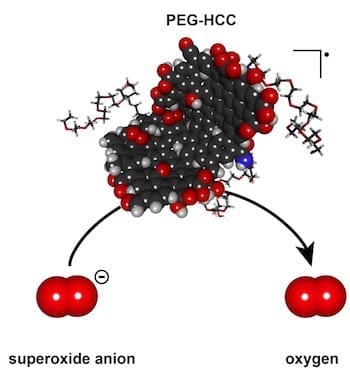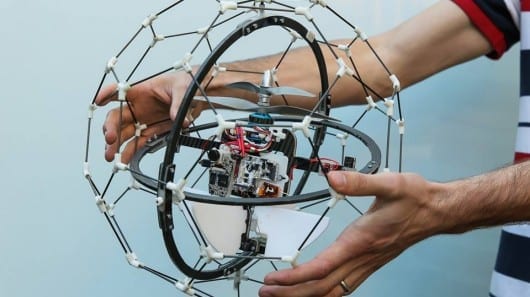
Rice-led study shows how particles quench damaging superoxides
Injectable nanoparticles that could protect an injured person from further damage due to oxidative stress have proven to be astoundingly effective in tests to study their mechanism.
Scientists at Rice University, Baylor College of Medicine and the University of Texas Health Science Center at Houston (UTHealth) Medical School designed methods to validate their 2012 discovery that combined polyethylene glycol-hydrophilic carbon clusters — known as PEG-HCCs — could quickly stem the process of overoxidation that can cause damage in the minutes and hours after an injury.
The tests revealed a single nanoparticle can quickly catalyze the neutralization of thousands of damaging reactive oxygen species molecules that are overexpressed by the body’s cells in response to an injury and turn the molecules into oxygen. These reactive species can damage cells and cause mutations, but PEG-HCCs appear to have an enormous capacity to turn them into less-reactive substances.
The researchers hope an injection of PEG-HCCs as soon as possible after an injury, such as traumatic brain injury or stroke, can mitigate further brain damage by restoring normal oxygen levels to the brain’s sensitive circulatory system.
The results were reported today in the Proceedings of the National Academy of Sciences.
“Effectively, they bring the level of reactive oxygen species back to normal almost instantly,” said Rice chemist James Tour. “This could be a useful tool for emergency responders who need to quickly stabilize an accident or heart attack victim or to treat soldiers in the field of battle.” Tour led the new study with neurologist Thomas Kent of Baylor College of Medicine and biochemist Ah-Lim Tsai of UTHealth.
PEG-HCCs are about 3 nanometers wide and 30 to 40 nanometers long and contain from 2,000 to 5,000 carbon atoms. In tests, an individual PEG-HCC nanoparticle can catalyze the conversion of 20,000 to a million reactive oxygen species molecules per second into molecular oxygen, which damaged tissues need, and hydrogen peroxide while quenching reactive intermediates.
Tour and Kent led the earlier research that determined an infusion of nontoxic PEG-HCCs may quickly stabilize blood flow in the brain and protect against reactive oxygen species molecules overexpressed by cells during a medical trauma, especially when accompanied by massive blood loss.
Their research targeted traumatic brain injuries, after which cells release an excessive amount of the reactive oxygen species known as a superoxide into the blood. These toxic free radicals are molecules with one unpaired electron that the immune system uses to kill invading microorganisms. In small concentrations, they contribute to a cell’s normal energy regulation. Generally, they are kept in check by superoxide dismutase, an enzyme that neutralizes superoxides.
But even mild traumas can release enough superoxides to overwhelm the brain’s natural defenses. In turn, superoxides can form such other reactive oxygen species as peroxynitrite that cause further damage.
“The current research shows PEG-HCCs work catalytically, extremely rapidly and with an enormous capacity to neutralize thousands upon thousands of the deleterious molecules, particularly superoxide and hydroxyl radicals that destroy normal tissue when left unregulated,” Tour said.
“This will be important not only in traumatic brain injury and stroke treatment, but for many acute injuries of any organ or tissue and in medical procedures such as organ transplantation,” he said. “Anytime tissue is stressed and thereby oxygen-starved, superoxide can form to further attack the surrounding good tissue.”
Read more: Nano-antioxidants prove their potential
The Latest on: Nano-antioxidants
[google_news title=”” keyword=”Nano-antioxidants” num_posts=”10″ blurb_length=”0″ show_thumb=”left”]
via Google News
The Latest on: Nano-antioxidants
- The 7 Best Zinc Sunscreens That Offer Full Sun Protection Without Irritating Sensitive Skinon April 30, 2024 at 8:03 am
Mineral sunscreen with zinc has long had a bad rap. But not these options. Shop seven options that you’ll actually want to apply—and reapply.
- The Best Korean Sunscreens for Every Skin Type and Toneon April 26, 2024 at 7:37 am
Korean sunscreens are not just a trend; they have captured the attention of skincare enthusiasts across the U.S. for the past decade. Five key factors — a lightweight feel, non-pore-clogging hydration ...
- Synthetic nanomaterial could be an effective tool for treating neurodegenerative diseaseson April 26, 2024 at 1:44 am
A newly developed nanomaterial that mimics the behavior of proteins could be an effective tool for treating Alzheimer's and other neurodegenerative diseases.
- 15 SPF Body Lotions to Accompany You on Every Vacationon April 25, 2024 at 2:07 pm
Fans of Sol de Janeiro’s Rio Radiance line will enjoy its expansion of sun protectors that come in a bevy of formulas to match your every mood. Of the three stars in the collection, the MVP is easily ...
- Nanomaterial that mimics proteins could be basis for new neurodegenerative disease treatmentson April 25, 2024 at 9:25 am
This nano-scale imitator is a product of a team led by Nathan ... Bound together under unstressed conditions, Keap1 releases Nrf2 to do its antioxidant work when needed. "Just in passing, Nathan and ...
- 7 Best CBD Creams, Lotions, and Balms for Pain in 2024on April 24, 2024 at 4:00 am
If you are feeling particularly sore after a hard workout or extended time sitting, a warming CBD cream may be the best option for you. This CBDfx warming CBD cream is similar to icy hot or other ...
- The 33 Best Natural Skincare Products in 2024on April 23, 2024 at 12:44 pm
Branded content. Us Weekly has affiliate partnerships so we may receive compensation for some links to products and services. One thing is for certain: Natural skincare is here to stay. Every year, ...
- Best Supplements for Athletes With Pain and Inflammation in 2024on April 23, 2024 at 12:36 pm
Dietary supplements just might be the perfect workout recovery solution for athletes. Whether you work out intensely or occasionally take a hike, bike, or swim, some supplements offer effective relief ...
- These Are the 10 Best Reef-Safe Sunscreens, According to Dermson April 22, 2024 at 3:30 pm
Reef-safe sunscreens are still being studied, but in the meantime, here are a few formulas you can feel good about purchasing.
- Meet The Winners Of The 2024 Women’s Health Beauty Awardson April 18, 2024 at 5:00 am
Team WH Beauty kicked off the official submission process for this year’s awards in November 2023, challenging brands to submit their superstars. But really, our editors are on the hunt for innovation ...
via Bing News









